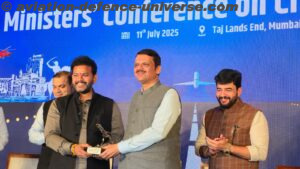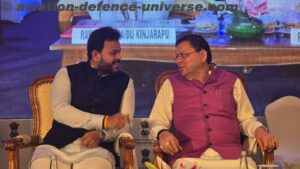By Our Special Correspondent
20 April,2016. All eyes are now on the Defence Acquisition Council meeting scheduled for tomorrow,21st April. Minister of State for Defence Rao Inderjit Singh talking to media persons on the side lines of a seminar on “Make in India for Indian Air Force’ in collaboration with CII, he informed that all the issues related to procurement of 36 fighter jets from Dassault Aviation of France have been resolved and the final decision is expected in the next meeting of the DAC. “Most of the hitches which were there had been addressed. Few things will be addressed when the matter comes up in the next DAC and I think there after road shall be clear,” he said.
Singh said both the Rafale and the indigenous light combat aircraft Tejas are needed for the country’s defence, not agreeing with a statement that at least six indigenously made Light Combat Aircraft Tejas can be bought for the price of one Rafale plane. He stated that both the aircraft were totally different in nature and that IAF needed both.
Meanwhile responding to the query on Rafale, Air Chief Marshal Arup Raha on the sidelines of the same seminar, said, “We have seen so many years go past. How can I give an assurance? But it is in a very advanced stage.”
The agenda of the seminar of course was that the officials of the Indian Air Force have prepared a 10-year modernization plan for expanding and optimising its horizons. The strategy identifies the technology and services which will enable the airborne wing of the Indian armed forces to be relevant in the 21st century, and share it with the private players, who have long aspired to be associated with the Indian military.
The 10-year modernization plans of the Indian Air Force share details of its requirements – key components such as aircraft tyres to rotor blades and 3D printing technology – with private industries so that they can set up their own manufacturing plants over the next decade, which will enable India to cut back on foreign defence imports. The figures released by the Indian Air Force details over Rs 2.5 lakh crore projected acquisitions, but experts indicate that only 10-15 percent of the projected budget will be supplied by domestic manufacturers, which will only maintain India’s reliance on imports. The Indigenisation Roadmap (2016-2025) is scheduled to be released at an event organised by the CII on Friday. The report lists a total of 174 parts – which include subsystems for Jaguar attack aircraft and spares for the AN-32 transport fleet – in dire need of indigenisation.
Though the Make in India initiative has gained widespread popularity, officials estimate that a large portion of the acquisition projects is not available in India. Thus, the Indian Air Force will have to rely on imports for at least the next 10 years.
The IAF chief, Air Chief Marshal Arup Raha, while addressing the audience said there is a “huge potential” for indigenisation in manufacture of capital equipment and spares. “The IAF is in the process of modernising and expanding its inventory to keep up with the changing geo-political scenario and emerging threat perception. There exists a huge potential for indigenisation in the manufacture of capital equipment and maintenance spares. Economical and optimal exploitation of such potential by the Indian industry would lead to greater self-reliance,” he informed.
He said that “A number of measures have been taken by the Government of India to promote indigenous development and manufacture of defence equipment. The DPP 2016, revised offset policy and enhanced FDI in defence sector are some such measures which offer several; incentives to the private industry to participate in defence production. I am glad that this seminar is being held and the Indian Air Force and CII has come together to participate in the same platform. The Indian Air Force has prepared its indigenization requirements for future technologies and new weapon system capabilities that they plan to induct, in the form of this form of a booklet.”
Besides hi-tech equipment like propulsion technology, engine systems and missile and bombs, the IAF feels that indigenisation is much-needed in smaller parts like tyre of the aircraft, batteries, bulbs, filters, fuel oil and lubricants.It also listed 173 requirements for maintenance of aircraft fleet and systems. However, the problem was that the annual requirement of most of the products listed was less than 30 units each.
In the face of rapid technological advancements and induction of new generation equipment in Indian Air Force, indigenization and modernisation of maintenance infrastructure has assumed a very significant role. IAF is on look out for modern repair facilities right from tools, testers, automation in repairs to material handling equipment for keeping it a highly vibrant and agile force. Indigenisation of weapon system and modernisation of maintenance facilities are closely inter-related and form the guiding principle for self reliance, self sufficiency and reduction of dependency on sources abroad. The industry has a very significant role to play in this regard.
The IAF vision for indigenisation is not limited to only a one-to-one replacement of imported items, but aims at improving upon operational efficiency and reliability through re-engineering, ab-initio design and technology enhancement. IAF is more than willing to extend full support to the entrepreneur or established industry in their contribution towards indigenisation and modernisation. At the same time, IAF is endeavoring to expand the range of indigenisation to include complex and high cost items, which may generate substantial business for the industry. It is now for the industry to make use of this opportunity to collaborate and consolidate their gains. In the longer run, the growth and additional opportunities would far outweigh the difficulties involved in the process, and in doing so, industry would not only be finding new avenues but, will also contribute towards the national objective of self-reliance.
Emerging industries within India have carved a niche for research and development and production of international quality products in the recent years. The cherished mission of IAF to make it self reliant is feasible only with the support and participation of Indian industry and in fact, today Indian industry has matured to take on this demanding role.
























































































































